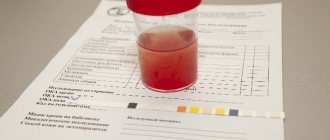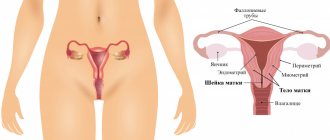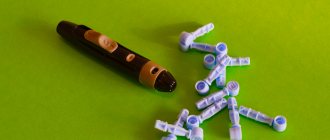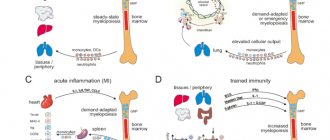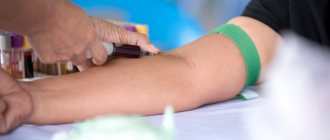What are ketone bodies?
The content of the article
These are compounds that arise as a result of biochemical changes in fats. Ketone bodies are formed in the liver, from where they enter the blood. In a healthy person, the rate of ketone bodies in the blood should not exceed 0.2 mmol/l.
Mechanism of formation of ketone bodies
Glucose is the main energy source for cells, but when it is deficient, energy comes from fats. There are 3 ketone bodies present in human urine and blood: B-hydroxybutyric acid, acetoacetic acid, and acetone.
Normal indicators
| Index | Result |
| Quantity | 50 ml |
| Color | Colorless, light yellow, straw yellow, yellow, amber yellow |
| Smell | Odorless or non-specific |
| Transparency | Transparent |
| Relative density of urine (specific gravity) | 1003-1035 |
| Urine reaction (pH) | 5.0-8.0 (in children under 1 month – 5.0-7.0) |
| Protein | > 0.140 g/l |
| Glucose | > 2.8 mmol/l |
| Ketone bodies | > 1 mmol/l |
| Urobilinogen | > 34 mmol/l |
| Bilirubin | Not detected |
| Hemoglobin | Not detected |
| Leukocyte esterase | Not detected |
| Nitrites | Not detected |
| Red blood cells | Up to 2 cells per field of view |
| Leukocytes | Up to 5 cells in field of view |
| Epithelium | Up to 5 squamous epithelial cells per field of view |
| Cylinders | Not detected |
| Crystals | Little or no detectable amounts of urates, calcium oxalates, amorphous phosphates |
| Slime | In small quantities |
| Bacteria | Not detected |
| Fungi | Not detected |
Ketones in urine - pay attention
The condition in which ketone bodies are present in the urine is called ketonuria. If ketone bodies are found in the urine, this means that the body is using fats for energy. There can be many reasons that cause ketonuria, along with associated symptoms.
Symptoms occur when the body is unable to utilize carbohydrates. which leads to fat burning in diabetic patients. In patients without diabetes, ketonuria may be caused by a lack of carbohydrates. The main thing is to determine the cause of ketones in the urine as soon as possible and begin appropriate treatment. Every day of delay matters.
Symptoms that may accompany ketonuria
If there are ketones in the urine or symptoms that may be associated with the presence of ketones in the urine, you should immediately consult an endocrinologist. Symptoms appear when ketonuria is already progressing.
Signs that may indicate the presence of ketone bodies:
- characteristic - fruity smell from the mouth - acetone, which is present in the exhaled air, is responsible for it ( this is the most characteristic symptom of ketonuria);
- high blood glucose levels greater than 300 mg/dL;
- skin color has changed, redness or vice versa - pale color;
- gastrointestinal symptoms - diarrhea, vomiting, abdominal pain;
- frequent infections;
- chronic fatigue;
- dry mouth and increased thirst;
- polyuria.
Treatment
DKA requires immediate hospitalization and intensive care. With correct measures taken, the condition resolves within 24 hours. Perform the following actions:
- Blood sugar levels return to normal.
- They flood the body.
- Restores mineral balance.
With timely detection and correct diagnosis, ketoacidosis resolves without complications or with minimal negative consequences. If there is delay, coma or death occurs. Control of nutrition and blood glucose levels is the main prevention of the development of DKA.
Study of urinary ketone bodies
Ketone bodies can be detected using urine strip testing. You need to donate mid-stream morning urine, when the first portion of urine goes into the toilet, the middle part goes into a specially prepared sterile container, and the last part goes back into the toilet.
Urine analysis testing
Before collecting urine, you need to wash yourself. During the period leading up to the urinalysis, do not change your diet or do too much exercise.
A normal urine body test for ketones is negative. If ketone bodies are detected in the urine, treatment should be started immediately.
Causes of ketone bodies in urine
- Diabetes, most often type 1 diabetes
. A diabetic's body cannot cope with burning carbohydrates. The reason for this is a deficiency of insulin, due to which fat reserves are mobilized for energy. As a result of these changes, ketone bodies are formed. Excess ketones accumulate in the blood, a condition called ketonemia. The body suffering from diabetes, wanting to get rid of excess ketones, releases them along with urine, as well as with exhaled air. Most often, ketone bodies in the urine are accompanied by hyperglycemia, that is, high levels of glucose in the blood, as well as the presence of glucose in the urine (glucosuria). An excess of ketone bodies in the body leads to the development of ketoacidosis. This is a life-threatening condition. Factors predisposing to ketoacidosis include: improper use of insulin, sudden cessation of insulin therapy, chronic infections, life-threatening conditions: stroke, heart attack, pancreatitis. - Low carbohydrate diet
. During prolonged fasting, ketone bodies are formed during excessive B-oxidation of fats. - Chronic alcoholism.
- Other reasons
- temporarily in case of severe vomiting, chronic fever, excessive physical exertion.
Having determined the cause of the presence of ketone bodies in the urine, the doctor will begin appropriate treatment.
Everything you need to know about ketones
In order to understand why it is necessary to monitor the level of ketones in urine and/or blood and under what circumstances this is really important, let's understand what ketones are and why they appear in human blood and urine.
The word ketone comes from the old German word Aketon (acetone). Ketones or ketone bodies are substances consisting of a combination of oxygen with hydrogen and a hydrocarbon.
There are many types of ketones, for example, ubiquinone, it is extremely important for the functioning of the heart; the ketone group contains fructose, progesterone, cortisone, tetracycline, camphor, natural dyes and many other substances.
Ketones are constantly synthesized in liver cells and are present in the urine and blood of every person; they are excreted daily in small quantities, of which
70% comes from weak beta-hydroxybutyric acid,
26% for the stronger acetoacetic acid (acetoacetate) and
4% for acetone.
Acetone, in addition, is also released during breathing, so such a small amount of it in urine cannot be determined using samples. It is believed that the norm for ketones in the urine of a healthy person is their complete absence.
To provide tissues and organs with energy, the body uses glucose or glycogen, which is stored in small quantities in the liver, as its source. When the intracellular glucose level is reduced and the cells “experience hunger,” the body’s fat reserves begin to mobilize.
Fat is broken down in the liver and during this process, byproducts are formed - ketone bodies. They can be used as an alternative source of energy by the kidneys, heart, muscles and brain.
A condition in which an excess of ketones is detected in the blood is called ketonemia, and in the urine - ketonuria. Most often, ketones are tested in urine, and there are a number of diseases and conditions that lead to ketonuria. These include: poor nutrition (starvation), excessive physical and emotional stress, frostbite, intoxication, severe infectious diseases and injuries, pancreatitis, thyrotoxicosis, alcoholism and diabetes.
What unites such different conditions, we can already answer - ketones are produced when cells are “starved” or when there is a deficiency of insulin, therefore, a distinction is made between “hungry ketones” and ketones in diabetes mellitus, although chemically these substances are no different.
During fasting, food does not enter the body, blood glucose levels decrease, insulin production stops and its antagonist, the hormone glucagon, enters the blood; it forces the body to use glycogen reserves located in the liver. When these reserves run out, adipose tissue begins to break down and ketones are formed.
In diabetes mellitus, the blood glucose level, on the contrary, is increased, but there is not enough insulin and glucose from the blood cannot enter the cell, the cell experiences “hunger”, but the body perceives this situation in the same way as during fasting. The hormones adrenaline and glucagon are produced, glycogen is broken down in the liver, then adipose tissue and ketones are formed. This situation is also called “hunger amid plenty.” Glucose circulates in excess in the bloodstream without entering the cells, the resulting ketones also enter the blood, and then both substances are excreted in the urine and only the administration of insulin can break this vicious circle.
Insulin deficiency can be caused by various reasons:
- The debut of type 1 diabetes mellitus, when a person does not pay due attention to the symptoms of the disease;
- Various conditions in patients with type 1 diabetes mellitus in which the need for insulin increases. For example, puberty, a period of active growth, an acute infectious disease accompanied by fever, surgery, injury;
- Missing insulin injections within 12-24 hours for any reason;
- Depletion of own insulin production in patients with type 2 diabetes mellitus;
- Concomitant diseases, surgeries, injuries in patients with type 2 diabetes mellitus;
- Taking various medications (cortisone, diuretics, estrogens, gestagens) by patients with both types of diabetes mellitus;
- Removal of the pancreas in persons who have not previously suffered from diabetes.
Related material:
Hormones that regulate blood glucose levels
Insulin and its importance for the body
About ketones. Briefly and in pictures
Ketoacidosis
The accumulation of ketones in the blood is called ketosis and, if the insulin deficiency is not corrected, ketones change the pH of the blood to the acidic side, have a toxic effect on the body and ketoacidosis .
The body tries to fight excess ketones by excreting them in the urine, urination becomes more frequent, and acetone is also excreted through the lungs, giving the exhaled air a specific “fruity” smell. Nausea, vomiting, abdominal pain, and general weakness also gradually increase; all this can lead to the development of a life-threatening condition - ketoacidotic coma. Treatment of ketoacidosis must be carried out in a hospital by administering the required volume of fluid and insulin.
It is extremely important to remember the following situations in which it is necessary to determine the level of ketones in the urine:
- You get sick, for example, with a cold accompanied by fever;
- Blood glucose level is more than 14-15 mmol/l for several hours;
- You have symptoms of insulin deficiency (nausea, vomiting, abdominal pain, rapid breathing, smell of “acetone” on your breath).
Related material:
Diabetic ketoacidosis. Video
Complications of diabetes
How can you determine the level of ketones in your urine?
Ketones in urine can be determined in the laboratory and at home. To do this, a special strip soaked in an alkaline substance and sodium nitroprusside is placed in the urine for 1 minute (available in pharmacies). If there are elevated levels of ketones in the urine, the strip changes color from white to brownish-red. The reaction is assessed using a color scale - “negative”, “small”, “medium” and “significant” ketone content. The test is easy to perform and can be performed an unlimited number of times.
For more accurate and specific results, you need to take a blood , which can also be done in the laboratory and at home. In addition, test strips react with urine acetoacetate and cannot detect beta-hydroxybutyric acid in urine, making them unsuitable for assessing the effectiveness of treatment for diabetic ketoacidosis.
The results are interpreted as follows: normal blood ketone levels should be below 0.6 mmol/L, a level of 0.6-1.5 mmol/L indicates the possibility of diabetic ketoacidosis, and > 1.5 mmol/L indicates a high risk ketoacidosis or existing ketoacidosis.
Comparison and Concordance of Blood and Urine Ketone Levels
| Blood ketone level (mmol/l) | Urine ketone levels |
| 0 – 0,5 | "negative" or "traces" |
| 0,6 – 1,0 | "traces" or "small" |
| 1,1 – 1,5 | "small" or "significant" |
| 1,5 – 3,0 | "significant" |
It is important to know about possible false-positive and false-negative results for determining ketonuria.
False-positive result (ketones are detected in the urine, but there is no risk of developing diabetic ketoacidosis) due to:
- Taking certain medications (for example: captopril, valproate);
- Acetone can circulate in the blood for many hours, even after the required dose of insulin has been administered. In this case, new ketones are not formed and are not detected in the blood.
False negative result (ketones in urine are not detected, but they are there) due to:
- Taking plenty of vitamin C (ascorbic acid) or salicylic acid (found in many painkillers such as aspirin);
- The lid of the can of stripes has been open for too long;
- The test strips have expired.
Thus, if ketones are detected in the morning urine and the blood glucose level is low, these are “starved ketones . You may experience general weakness and nausea; if such symptoms appear, you need to eat carbohydrate-containing food, followed by the introduction of the required dose of insulin. Also be sure to check your blood glucose levels the following night to rule out the possibility of nocturnal hypoglycemia. A high level of glucose in the urine indicates that blood glucose levels were high during the night, although they are low in the morning hours.
If the level of ketones in the urine (and/or blood) is high and the blood glucose level exceeds 15-20 mmol/L, this indicates insulin deficiency . The number one priority is to administer an additional dose of insulin. That's why:
- Enter 0.1 U/kg body weight of short-acting insulin (preferably Novorapid or Humalog);
- Determine your blood glucose level after 1-2 hours;
- Give another 0.1 U/kg body weight if blood glucose levels have not decreased;
- Do not administer short-acting insulin more frequently than every 3 hours to avoid delayed hypoglycemia;
- Determine the level of ketones in the blood an hour after administering an additional dose of insulin - it should decrease;
- Consume more fluids (water);
- If your blood ketone level is 3 mmol/L or more, consult a doctor immediately!
Ketones during pregnancy
A common cause of concern is the detection of ketones in urine in pregnant women. About 30% of pregnant women who do not have diabetes have ketones in their morning urine.
Ketones in urine during pregnancy can be observed if a woman follows a carbohydrate-free diet for a long time, in case of poisoning, infectious diseases, severe emotional stress, or gestosis. Ketones in urine can also signal diabetes.
Pregnancy is a period during which there is a risk of developing so-called specific diabetes of pregnant women or gestational diabetes mellitus. The disease usually disappears on its own after childbirth, but during pregnancy it can significantly affect the development of the baby. Therefore, when ketones are detected in the urine during pregnancy, first of all, it is important to exclude diabetes mellitus, including type 1 diabetes mellitus, the onset of which may coincide with the onset of pregnancy.
During different periods of pregnancy, women with type 1 diabetes have different insulin needs. It is reduced at the beginning of pregnancy, and then rises steadily, until almost 36-38 weeks, when it becomes twice as high as before pregnancy. This is due to weight gain during pregnancy and the secretion of hormones produced by the placenta that counteract the decrease in blood glucose levels.
During pregnancy, ketone production increases during periods of insulin deficiency, making the development of ketoacidosis more likely.
Ketoacidosis during pregnancy is very dangerous for both mother and baby.
It is necessary to regularly monitor the level of ketones in the blood or urine, especially if you feel unwell or have an illness accompanied by a fever. Eating “slow carbohydrates” before bed reduces the risk of hypoglycemia at night and the appearance of “hungry ketones.”
Thus, the level of ketones is undoubtedly an important indicator, the control of which does not require much effort (determining the level of ketones in urine or blood takes no more than 5 minutes), but answers many questions related to the disease. Timely control prevents the development of a life-threatening condition – diabetic ketoacidosis.
Related material:
Gestational diabetes mellitus
Diabetes and pregnancy
6 myths about diabetes and pregnancy
Ketones in urine - the rate of acetone in urine and interpretation of the result
The norm for ketones in urine is the absence of ketone bodies. Any positive result (positive ket in the urine) means a problem in the body and requires further diagnosis. Traces of ketones in urine or low levels, such as urinary ketones 5 or urinary ketones 15 mg/dL, may indicate:
- intense physical effort;
- lack of calories in the diet;
- vomiting;
- fever;
- burns;
- alcohol consumption.
Intense physical effort
Fever
Most often, mild ketonuria occurs without symptoms that may indicate diabetes or ketoacidosis.
Excessively high levels of urinary ketones, that is, a test result indicating a urine ketone level of 50 mg/dL or more, may indicate more serious health problems such as severe debilitating diseases, thyroid disease, or renal glycosuria. High ketones in urine also accompany decompensated or undiagnosed and untreated diabetes.
What may affect the results
Factors that may distort the results of the study:
- Violation of hygiene procedures and urine collection techniques.
- Drinking large or small amounts of water.
- Consuming foods, medications, or dietary supplements that change the color of urine.
- Menstruation.
- High blood pressure.
- Intense physical and psycho-emotional stress on the eve of urine collection.
- Visiting a bathhouse, sauna, hypothermia.
- Carrying out invasive procedures on the urinary tract a week before the test.
You can take a general urine test at the nearest INVITRO medical office.
A list of offices where biomaterial is accepted for laboratory research is presented in the “Addresses” section. Urine examination includes the study of physical and chemical properties, as well as microscopy of sediment.
Physical properties: quantity, color, odor, transparency, relative density (specific gravity), urine reaction (pH).
Chemical properties: determination of protein, glucose, ketone bodies, urobilinogen, bilirubin, hemoglobin, nitrites, leukocyte esterase.
Microscopy: identification of erythrocytes, leukocytes, cells of flat, transitional and renal epithelium, cylinders, crystals, mucus, bacteria, fungi.
Ketones in a child's urine - reasons
Acetone in the urine in children is most often accompanied by vomiting or fever. Sometimes this is a sign of malnutrition or adrenal insufficiency - then high levels of ketone bodies in children's urine are accompanied by hypoglycemia, that is, low blood glucose levels. Conversely, ketones in the urine when glucose levels are low and the liver is enlarged may indicate the presence of glycogenosis.
Ketone bodies and glucose in a child's urine may indicate diabetes; Type 1 diabetes is most common in young adults. To determine whether a child has ketones, it is necessary to first measure fasting blood glucose levels. Further diagnosis depends on the glucose result.
Why is ammonia dangerous?
An increase in the level of ammonia in the blood leads to the fact that it begins to penetrate various organs and tissues and, first of all, the brain. Ammonia is lipophilic, so it is easy for the ammonia molecule to penetrate the lipid membranes of brain cells. An increase in ammonia levels and its penetration through the blood-brain barrier is accompanied by various neurological symptoms, including depression of consciousness and the development of coma. In children, hyperammonemia may be accompanied by loss of skills and impairment of neuropsychological development.
Ketone bodies in urine during pregnancy - what do they show?
Ketones in urine are not uncommon during pregnancy. Women who suffer from frequent vomiting in the first trimester of pregnancy show the presence of ketones very often. In addition, lack of appetite during pregnancy or skipping an evening meal the day before urine tests can lead to an increase in ketone bodies in the blood and urine.
Since high levels of acetone in the urine of a pregnant woman may indicate gestational diabetes, the condition always requires further diagnosis. Then, in addition to ketones, glucose may also be observed in the urine of a pregnant woman, and there may also be symptoms of ketoacidosis.
Traces of ketones in urine - treatment
Ketonuria is not a disease, but a symptom of a disease, so it cannot be cured. To restore urinary ketone levels to normal, the underlying condition must be eliminated or treated. It is necessary to compensate for disturbances in acid-base and water-electrolyte metabolism. This is especially important in the case of diabetes, a complication of which can be ketone coma.
To get rid of ketones in the urine in diabetes, it is necessary to normalize the levels of glucose and insulin in the blood. In case of ketonuria caused by malnutrition, it is necessary to change the diet to a high-calorie diet and ensure an adequate caloric balance. During vomiting, antiemetic drugs are prescribed.
ONLINE REGISTRATION at the DIANA clinic
You can sign up by calling the toll-free phone number 8-800-707-15-60 or filling out the contact form. In this case, we will contact you ourselves.
